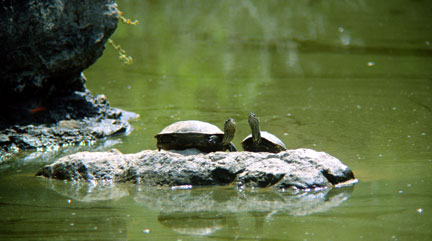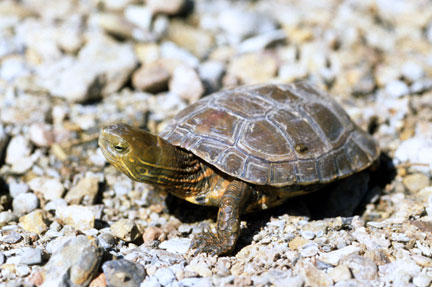
![]() An introduction to the Mauremys turtles of the Mediterranean
An introduction to the Mauremys turtles of the Mediterranean
A C Highfield

Above: Mauremys caspica basking on a rock in Turkey. The distinctive finely striped neck of this species is just visible.
Freshwater turtles of the genus Mauremys are widely distributed in Asia and are also found in many areas bordering the Mediterranean. Mauremys encompasses four species, of which the best known are the Mediterranean species Mauremys caspica (the Caspian turtle) and Mauremys leprosa (the Spanish turtle). M. caspica occurs from the south-western former Soviet Union through Turkey, Bulgaria, Iran, Israel and many other Middle Eastern localities. M. leprosa is found from Portugal, Morocco, Spain, Algeria, Tunisia and Libya to Senegal and Niger in north-western Africa. No subspecies are currently recognised for M. leprosa, but M. caspica is now generally recognised as comprising two subspecies, M. c. caspica and M. c. rivulata. The former race occurs in eastern and central Turkey, Iran, Iraq, Saudi Arabia and into the former USSR whilst M. c. rivulata is found in western Turkey, southeastern Europe including Greece, Bulgaria, Syria, Lebanon and Israel. The plastron of M. c. rivulata is generally black, compared to the paler, blotched, plastron of M. c. caspica. However, this is by no means always the case and this feature should not be considered as entirely reliable for diagnostic purposes. The two non-Mediterranean members of the genus Mauremys are less frequently encountered; Mauremys nigricans (the Asian yellow pond turtle) and Mauremys japonica (the Japanese turtle). It should also be noted that some authorities continue to attribute all of the species comprising the genus Mauremys to the genus Clemmys - but this is not a widely held opinion.
Although Mauremys have a reputation as rather dull and unattractive turtles, this is rather misleading. Whilst it is true that old specimens - especially of M. caspica - tend to possess a uniformly dull greenish-brown carapace, younger specimens of M. leprosa often feature brilliantly coloured neck stripes and attractive red-orange markings on the carapace.

An attractively marked example of Mauremys leprosa - I found this one in a slow moving stream in Spain.
![]() Although both M. caspica and M. leprosa are medium-sized turtles (23.5 cm and 18 cm maximum respectively) most field populations are heavily biased in favour of much smaller specimens. 85% of a Spanish population of M. leprosa I measured recently were less than 12 cm in length and the largest M. caspica I have encountered was in Southern Turkey, where a female of considerable age measured 19 cm.
Although both M. caspica and M. leprosa are medium-sized turtles (23.5 cm and 18 cm maximum respectively) most field populations are heavily biased in favour of much smaller specimens. 85% of a Spanish population of M. leprosa I measured recently were less than 12 cm in length and the largest M. caspica I have encountered was in Southern Turkey, where a female of considerable age measured 19 cm.
Natural habitats and lifestyle
Mauremys caspica and M. leprosa occur in a wide variety of habitats from fast flowing mountain streams to ponds and drainage ditches. In Spain, Greece and Turkey I have regularly found good populations of Mauremys in deep rock-pools adjacent to mountain streams. In Morocco and Tunisia the most common habitats include seasonal ponds, lakes, irrigation ditches and brackish coastal lagoons.
![]() Mauremys terrapins are highly tolerant of a wide range of water conditions; they are found in acid, alkaline and brackish water. Unlike Emys orbicularis (the European pond terrapin) with which they are sometimes sympatric, Mauremys spp. can also survive in severely polluted waters. Apparently healthy populations of Mauremys leprosa have even been observed living in open sewers. In Morocco I found several very large specimens in an extremely saline pond which was also used as a garbage tip by local people. This pond, like many others in the region, dries up completely in summer. The turtles respond by aestivating to escape the searing heat (47
degrees C) experienced during this period. In more northerly areas, Mauremys spp. hibernate during the winter but in southern Morocco M. leprosa remain active all through the winter.
Mauremys terrapins are highly tolerant of a wide range of water conditions; they are found in acid, alkaline and brackish water. Unlike Emys orbicularis (the European pond terrapin) with which they are sometimes sympatric, Mauremys spp. can also survive in severely polluted waters. Apparently healthy populations of Mauremys leprosa have even been observed living in open sewers. In Morocco I found several very large specimens in an extremely saline pond which was also used as a garbage tip by local people. This pond, like many others in the region, dries up completely in summer. The turtles respond by aestivating to escape the searing heat (47
degrees C) experienced during this period. In more northerly areas, Mauremys spp. hibernate during the winter but in southern Morocco M. leprosa remain active all through the winter.
![]() I recently measured the water conditions of isolated mountain populations of Mauremys leprosa in Southern Spain and found that water temperatures in March-April ranged from 12-16
C with a pH of 8 (strongly alkaline). In these conditions numerous turtles could be observed basking on large rocks from about 10 a.m. onwards every morning. At the slightest sign of disturbance they would disperse with a flurry of splashes back into their rock pools where they would disappear into a thick carpet of pond weed.
I recently measured the water conditions of isolated mountain populations of Mauremys leprosa in Southern Spain and found that water temperatures in March-April ranged from 12-16
C with a pH of 8 (strongly alkaline). In these conditions numerous turtles could be observed basking on large rocks from about 10 a.m. onwards every morning. At the slightest sign of disturbance they would disperse with a flurry of splashes back into their rock pools where they would disappear into a thick carpet of pond weed.
![]() In order to photograph the colourful examples of M. leprosa shown here I approached the turtles from downstream to avoid throwing up too much sediment into the crystal clear water of the rock pool. As I got to within 15 feet of their basking rock all of the turtles simultaneously dived for cover. I continued my approach, first ankle-deep, then knee deep, in the thick oozy sediment of the stream. As the water rose to waist-height and I continued my slow and careful approach, curiosity began to get the better of them and I found myself being observed by several small heads poking through the submerged weeds. I made a quick grab and retrieved a particularly attractively marked young male. He made no attempt to bite but did produce an extremely malodorous discharge.
In order to photograph the colourful examples of M. leprosa shown here I approached the turtles from downstream to avoid throwing up too much sediment into the crystal clear water of the rock pool. As I got to within 15 feet of their basking rock all of the turtles simultaneously dived for cover. I continued my approach, first ankle-deep, then knee deep, in the thick oozy sediment of the stream. As the water rose to waist-height and I continued my slow and careful approach, curiosity began to get the better of them and I found myself being observed by several small heads poking through the submerged weeds. I made a quick grab and retrieved a particularly attractively marked young male. He made no attempt to bite but did produce an extremely malodorous discharge.
Conservation and threats
Mediterranean freshwater turtles face a number of threats. In addition to the (obvious) dangers such as drainage of wetlands and the facing of drainage ditches with concrete slabs, agricultural practices such as excessive groundwater extraction and over-use of pesticides and fertilisers are serious concerns. Road kills also take a significant toll in some areas. The introduction of American Red-eared turtles (Trachemys scripta elegans), imported into the Mediterranean region in vast numbers as pets, is a growing threat in the long-term as they compete directly for food with indigenous species. In Morocco Mauremys leprosa is also killed in order to manufacture grisly 'souvenirs' destined for sale to foreign tourists. The eggs of M. caspica and M. leprosa are also used in Arabic medicinal lore as treatments for a range of conditions from upset stomachs to poor sight. Fortunately awareness of these problems is also growing and a number of important habitats are now designated as protected areas.
Captive care
All Mauremys spp. are fond of basking and will appreciate a sunny slope or basking ramp under a spot-lamp. Whilst these turtles can be maintained successfully in large aquarium tanks, if local climate permits an outdoor pond is recommended - at least in summer. If aquarium tanks are used a combination of under-gravel and foam canister filtration is suggested. The under-gravel element will provide biological filtration, breaking down ammonia and nitrites, whilst the canister unit will assist particulate removal. For large tanks and outdoor ponds I generally prefer a koi-type chamber filter containing layered foam and fed by a submersible pump. The outlet from the filter chamber is gravity-fed back into the tank or pool; an ultra-violet steriliser can also be added at this stage. This will ensure that algae growth ('green water') is severely inhibited and the UV-C tube will also help reduce water-born bacteria, viruses and protozoans. This combination of koi-type filter and UV steriliser has proved extremely effective and is now our standard filtration set-up for all tanks and ponds of 250 gallons or over. The pump should be selected to provide a complete water cycle every 90 minutes although higher throughputs can also be used.
Diet
The natural diet of Mauremys is highly biased towards filamentous algae, insect larvae, earthworms, molluscs, small amphibians and tadpoles and various aquatic plants. M. leprosa is also known to be particularly partial to carrion. In captivity, Mauremys rarely present any problem, almost always feed in the water and enjoy an eclectic diet comprised of trout chow, rehydrated cat and dog treats, fresh green-leafed vegetation, snails, worms and a small amount of low-fat tinned pet food. Our usual practice is to provide at least one meal each week of dried cat treats which have been rehydrated with added vitamins and calcium. As they hydrate, the treats absorb the supplements; this avoids the common problem with 'water feeders' of supplements being washed off almost immediately upon presentation. We find that feeding 3 days out of 7 is usually most appropriate for Mauremys turtles. If more frequent feeding is employed then growth may be excessive and water hygiene problems will be amplified.
Reproduction
Mating usually occurs underwater, but occasionally may take place on land. Females can sustain serious bites to the face and neck at this time, so should be placed under careful observation. Males can sometimes be mutually aggressive, but I have maintained two male M. caspica together for several years with no evident problems (these specimens also happily share a pond with Cuora amboinensis). M. caspica lays clutches of 4-6 eggs measuring 25 x 38 mm. M. leprosa lays slightly larger clutches, of between 5-10 eggs measuring 36 x 22 mm. These can be incubated successfully in a medium-high humidity environment (75-90%) at 27-30C. The average incubation period at these temperatures is 65-75 days. The juveniles are initially carnivorous and usually feed first upon insect larvae.
In summary, Mauremys turtles are much more interesting and attractive creatures than many give them credit for. I have maintained them in captivity for many years and always find them fascinating to watch as they are both intelligent and responsive. Their natural ecology is equally fascinating - and there is still much to discover about their reproductive biology and taxonomy.
(c) 1993-2002 A. C. Highfield